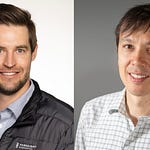Chapters:
0:00 “It’s a magical time.”
9:55 Tracking low-concentration proteins in real-time
19:20 What next?
24:40 Proteins act in community
29:30 Challenges ahead?
Many new drugs and clinical diagnostics are being derived from proteins. Today we take our proteomics series into the clinic with Jenny Van Eyk from Cedars Sinai Hospital in Los Angeles and Daniel Hornburg of the proteomics company, Seer.
Jenny works at that sweet spot with one foot in the clinic and the other in research, specifically tool development. The two talk about the new ability made possible by Seer’s Proteograph to look at proteins in real-time, to capture not only the biomarker but the activity of the biomarker. They talk of the importance of being able to see the concerted effort of multiple proteins in developing clinical assays.
Jenny highlights her work with the GLP1 peptide, which is key to the new weight loss and diabetes drugs. She says there are two main ways that proteins regulate the body. One is through degradation and the other is to be sequestered by other proteins.
“Sometimes only a small portion of the proteins are active. And that’s what we need to know,” says Jenny. "Only by understanding what’s really close to the biology, close to the disease can we get it right."
Today’s show is made free through the generous support of Seer. For decades, a limiting factor in proteomics research has been the inability to access the proteome in ways necessary to survey and understand its diversity. So, Seer created their new Proteograph(TM) to provide a more transformative lens of the proteome.











